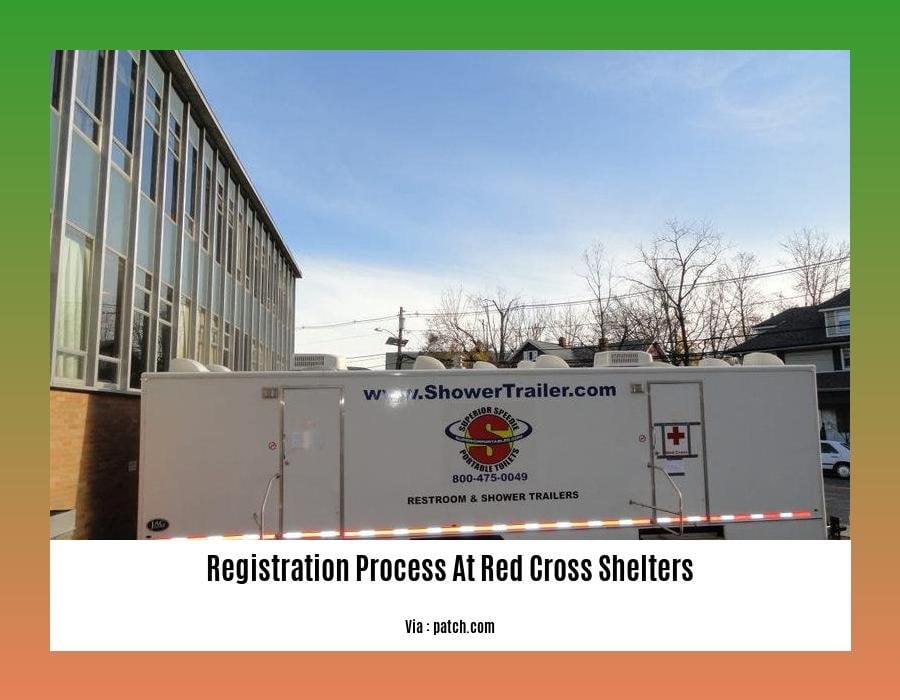Navigating the Registration Process at Red Cross Shelters: A Step-by-Step Guide

Key Takeaways:
- Red Cross shelters provide safe haven during crises.
- Shelter staff guide registration, ensuring access to services.
- Shelters offer medical care, prescription refills, and lost item replacement.
- Registration helps identify clients with medical needs for Disaster Health Services.
- Shelters prioritize resourcing before opening but may welcome clients during setup.
Registration Process at Red Cross Shelters
If a disaster strikes, Red Cross shelters provide refuge during emergencies. The registration process at Red Cross shelters is crucial for receiving essential assistance. Here’s a step-by-step guide to help you navigate it effectively:
Arrive at the shelter: Upon arrival, you’ll be greeted by Red Cross staff who will guide you through the registration process.
Provide basic information: You’ll be asked for basic information such as your name, contact details, address, household size, and any medical needs.
Gather necessary documents: Bring a driver’s license or government-issued ID, Social Security card, insurance information, and medical records to expedite the process.
Complete the screening: The Red Cross will conduct an initial screening to assess your immediate needs and develop a plan for assistance.
Receive identification: You’ll be issued a Red Cross ID card for identification and tracking purposes.
Access financial assistance: If eligible, you can receive cash or financial assistance for expenses like food and shelter.
Additional Support and Services:
Beyond registration, Red Cross shelters offer various support and services, including:
- Food and water
- Medical care
- Emotional support
- Referrals to other aid organizations
Important Considerations:
- Registration is free and open to all individuals and families affected by the disaster.
- Privacy and confidentiality are strictly maintained.
- Safety measures like background checks may be implemented during registration.
- Please be patient and respectful of staff and other individuals seeking assistance.
Find the up-to-date emergency shelter locations and capacity updates and follow the guidelines for setting up mass care facilities to ensure the well-being of those affected. If the situation prolongs, transitioning to interim shelters should be considered.
Registration Procedure
When seeking shelter during a disaster, registering at a Red Cross shelter is crucial for accessing essential assistance. Here’s a step-by-step guide:
Step 1: Arrive and Provide Basic Information
Upon arrival, you’ll be greeted and asked to provide your name, contact information, address, household size, and medical needs.
Step 2: Gather Documents
To expedite the process, bring documents such as ID, Social Security card, insurance information, and medical records.
Step 3: Initial Screening
A staff member will assess your needs and develop an assistance plan.
Step 4: Identification
You’ll receive a Red Cross ID card for identification and tracking purposes.
Step 5: Financial Assistance (if eligible)
If you qualify, you may receive cash or financial assistance for expenses like food and shelter.
Key Takeaways:
- Registration is free and open to all affected individuals.
- Privacy and confidentiality are strictly maintained.
- Red Cross shelters offer various support services, including food, medical care, and emotional support.
- Respect and patience are essential during the registration process.
- Please bring required documents to expedite registration.
Source: Red Cross Sheltering Handbook
Additional Support and Services
Beyond registration, Red Cross shelters offer a comprehensive range of support and services to assist individuals and families affected by emergencies. These services are designed to provide comfort, support, and essential resources during challenging times.
Key Takeaways:
- Food and Water: Shelters provide nutritious meals and clean drinking water to ensure the well-being of residents.
- Medical Care: Shelters have trained medical professionals on-site to provide first aid, triage, and basic medical care.
- Emotional Support: Staff and volunteers offer emotional support, counseling, and comfort to those experiencing distress or trauma.
- Referrals to Other Aid Organizations: Shelters work closely with other aid agencies to connect residents with additional resources, such as financial assistance, housing support, and mental health services.
Citation:
- American Red Cross Sheltering Handbook
Important Considerations for Red Cross Shelter Registration
In times of crisis, registering at a Red Cross shelter is crucial for accessing essential support. This guide highlights key considerations to ensure a smooth and effective registration process:
Eligibility and Documentation:
* Eligibility: Registration is open to all individuals and families affected by the disaster.
* Documentation: While not mandatory, documents such as ID cards, Social Security cards, and medical records can expedite the process.
Timeliness:
* Register promptly to secure access to food, shelter, and medical assistance. Delays may limit resources available.
Confidentiality and Privacy:
* Confidentiality: Your personal information is protected and kept confidential.
* Privacy: Respect the privacy of other individuals seeking assistance.
Vulnerable Individuals:
* Children: Young ones need special attention. Seek assistance from Red Cross staff for their needs.
* Elderly and Disabled: They may require additional support. Inform staff about their specific requirements.
Safety and Respect:
* Safety: Follow instructions from Red Cross staff for security measures, including background checks.
* Respect: Treat everyone present with respect, including staff, volunteers, and fellow shelter residents.
Other Important Points:
* Assistance: Beyond registration, Red Cross shelters provide a range of support services, such as food, medical care, and emotional support.
* Referrals: Staff can provide referrals to additional aid organizations that can assist you.
Key Takeaways:
- Registration is free and open to all affected individuals.
- Bring necessary documentation to expedite the process.
- Register promptly to secure access to essential resources.
- Your privacy and confidentiality are respected.
- Pay attention to the needs of vulnerable individuals.
- Follow safety and respect guidelines.
- Utilize the additional support and referral services available.
Citation:
* American Red Cross Sheltering Handbook











